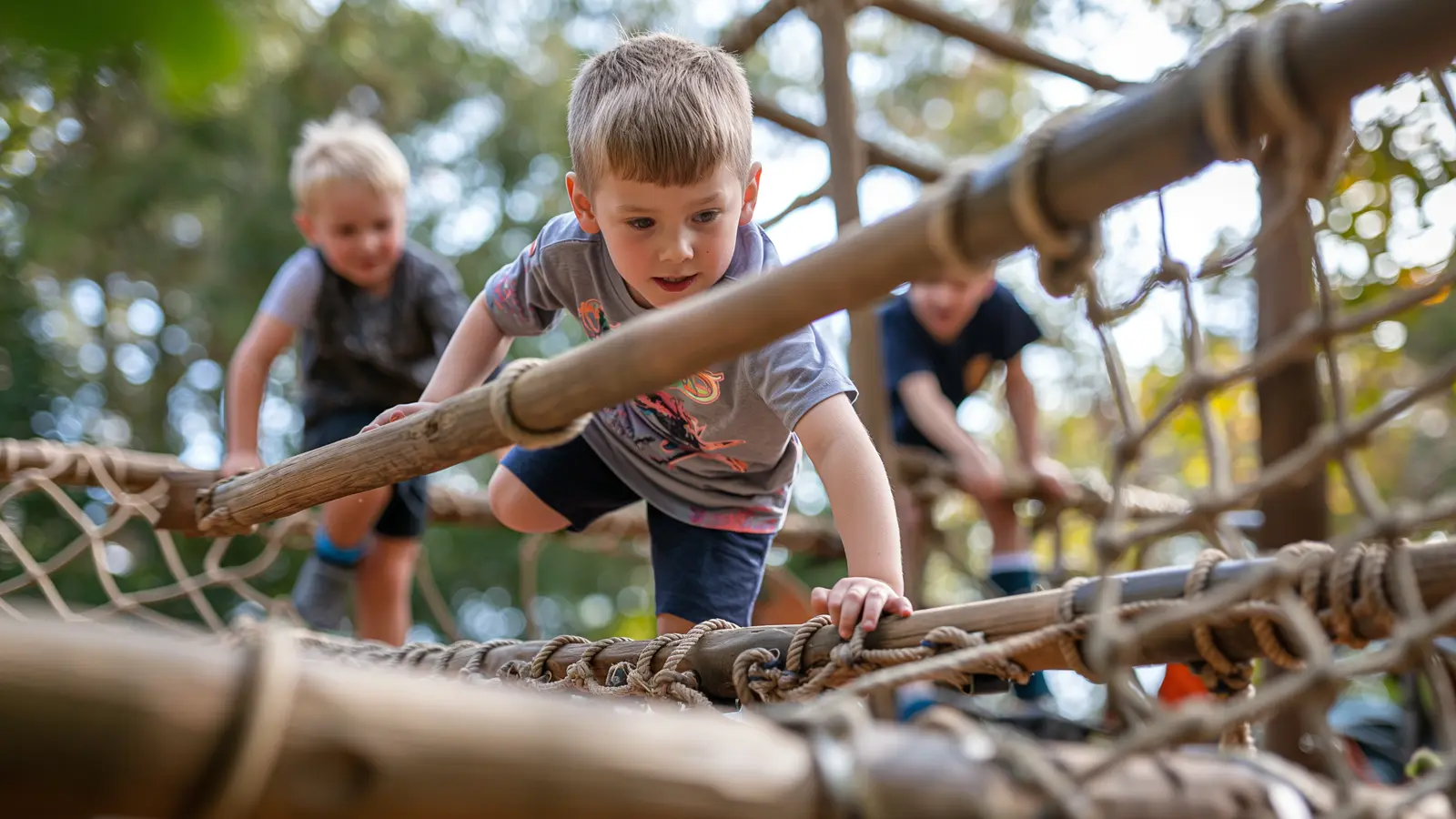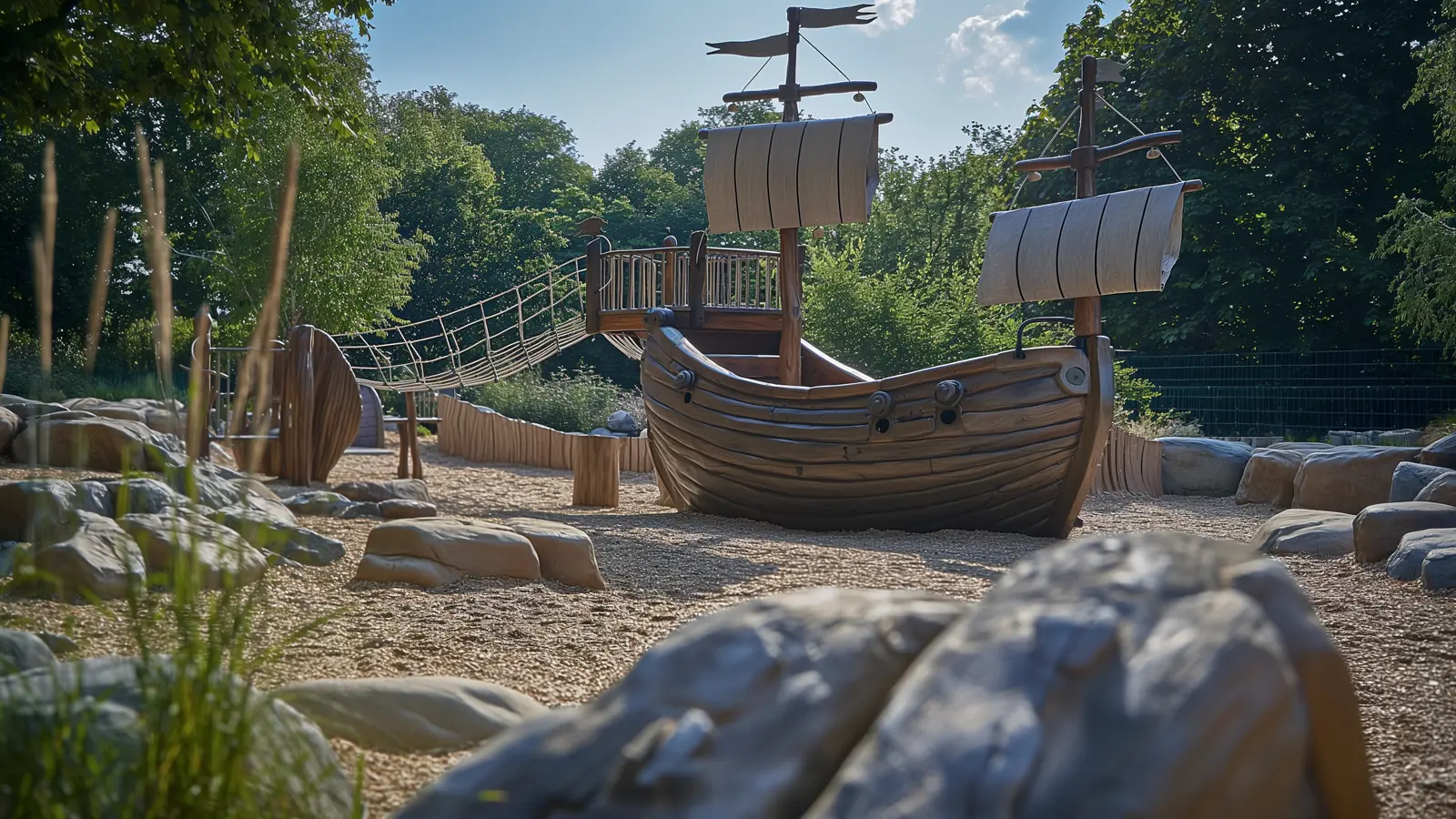2024-07-05
Designing the Perfect Adventure Play Park
Creating a vibrant and engaging adventure play park involves more than just installing equipment. It requires thoughtful design that encourages creativity, promotes physical development, and ensures safety for children of all ages. A well-designed adventure playground attracts kids and provides a dynamic environment where they can grow, learn, and have fun. Whether you’re planning an adventure playground for a city park, a school, or a community space, these tips and ideas will help you create a play area that delights children and visitors alike, transforming ordinary spaces into extraordinary play destinations.
Adventure playgrounds are a haven for kids, offering a space to play freely, explore their creativity, and enjoy endless fun. These playgrounds are designed to challenge and stimulate children, providing an environment that supports their physical and mental development. The diverse play elements in adventure playgrounds—from climbing structures to water features—cater to various interests and skill levels, ensuring every child finds something engaging and exciting. By incorporating features that encourage imaginative play and physical activity, these playgrounds become essential in promoting a healthy, active lifestyle for children. The sheer joy and laughter of kids in these spaces are truly inspiring.
This article will guide you through the key considerations for designing the perfect adventure play park, drawing inspiration from successful examples and expert advice. We will explore practical steps for site selection, layout, and incorporating natural elements, all of which create a welcoming and stimulating environment. Additionally, we will discuss the importance of community involvement and the role of events and programming in maintaining long-term engagement. With a focus on safety, creativity, and community, you will be equipped with the knowledge to create an adventure playground that remains a beloved destination for families and kids for years to come. Plan a visit to successful playgrounds, learn from their designs, and create a space that offers free play and endless opportunities for adventure.


Key Elements of an Adventure Playground
Designing the perfect adventure play park requires a deep understanding of the essential elements that make playgrounds fun but also safe and inclusive. Adventure playgrounds offer a unique blend of creative play, engaging challenges, and safety features, ensuring children can play freely while developing critical skills. These playgrounds are more than play areas; they are dynamic environments where children and families can explore, imagine, and discover.
Key elements to consider:
- Safety and accessibility to ensure all children can enjoy the playground regardless of ability.
- Creative play and imagination, incorporating elements like climbing structures and water features.
- Engaging in challenges catering to different ages and skill levels promotes physical and mental development.
Creating an adventure playground involves thoughtful planning and attention to detail to ensure that it remains a cherished spot for visitors of all ages. From the initial design stage to the day the adventure playground opens, every aspect must be carefully considered to foster an environment where creativity and play thrive.
Safety and Accessibility
Safety is paramount when designing the perfect adventure play park. Ensuring that all play elements meet stringent safety standards is crucial to creating an environment where children can play freely without unnecessary risks. This includes regular safety checks and maintenance to keep the equipment in top condition.
Accessibility is equally important. Adventure playgrounds should be designed to accommodate children of all abilities, ensuring everyone can participate and enjoy the fun. This can be achieved by including ramps, wide pathways, and sensory play areas that cater to children with different needs. Ensuring the playground is inclusive will make it a beloved destination for families and visitors from all over.
Creative Play and Imagination
Adventure playgrounds are designed to spark children’s creativity and imagination. Elements like climbing structures, sand pits, and water features provide endless opportunities for creative play. These features encourage children to explore, imagine, and engage in activities stimulating their minds and bodies.
For example, the adventure playground in Central Park is renowned for its innovative design that fosters creative play. With areas specifically designed for discovery and exploration, children can immerse themselves in a world of imagination. Incorporating natural elements like trees and rocks further enhances the creative experience, making the playground a true adventure for kids.
Engaging Challenges
Incorporating engaging challenges into the design of an adventure playground is essential for promoting physical and mental development. Play elements that cater to different ages and skill levels ensure that children are constantly challenged and stimulated. This can include obstacle courses, climbing walls, and interactive games that test physical endurance and cognitive skills.
Having a variety of play elements allows children to develop at their own pace while remaining engaged and entertained. For instance, city parks with adventure playgrounds often include activities ranging from simple climbing frames for younger children to more complex structures for older kids. This variety ensures that the playground remains a popular destination for families and provides a comprehensive play experience that supports overall child development.


Practical Steps for Designing an Adventure Play Park
Selecting the right site is crucial when designing the perfect adventure play park. The location should be easily accessible to families and visitors, ideally in a central or city park. These locations attract more visitors and offer the necessary infrastructure and safety measures. An adventure playground in a central, well-trafficked area can become a vibrant hub of activity, encouraging children to play freely and explore.
Maximizing space and ensuring a natural flow between different play areas is important when planning the layout. This can be achieved by strategically placing play elements to create distinct zones for different activities. For example, a climbing area could be adjacent to a sand pit, allowing children to move seamlessly from one activity to another. Clear pathways and signage can help guide visitors through the park, making it easy to navigate and enjoy all the amenities.
Key tips for an effective layout include:
- Zoning: Create separate areas for different types of play (e.g., active play, creative play, and quiet zones).
- Pathways: Design clear, accessible pathways that connect all playground areas.
- Visibility: Ensure parents and caregivers can easily see their children from any point in the park.
- Safety: Incorporate safety features such as soft surfaces, shaded areas, and fencing where necessary.
Incorporating natural elements into the adventure playground design enhances the play experience and promotes a connection with nature. Trees, rocks, and water features make the environment more immersive and provide opportunities for creative play and discovery. These natural elements can create sensory-rich play areas that stimulate the imagination and offer unique challenges. For instance, a water play area with streams and fountains can encourage children to engage in exploratory play, while a climbing structure built around existing trees can add an element of adventure. The benefits of these natural elements include promoting physical activity, fostering a love for nature, and providing a unique play experience that children will remember.
Amenities and facilities are not just add-ons; they are essential to making the adventure play park comfortable and enjoyable for families. Restrooms, seating areas, and shade structures are necessities that ensure visitors can stay for extended periods without discomfort. Additionally, picnic areas and interactive sculptures can enhance the play experience and provide family spaces to relax and interact. By carefully considering site selection, layout, natural elements, and amenities, designers can create an adventure playground that remains a favorite destination for children and families.


Ensuring Long-Term Success and Engagement
Regular maintenance and safety checks are vital to keeping an adventure playground safe and appealing for visitors. Ensuring all equipment remains in good condition protects children from potential hazards and extends the playground elements’ lifespan. Park managers should establish a routine inspection and repair schedule and promptly address wear and tear.
A thorough maintenance checklist can help park managers carry out these tasks efficiently. Key considerations include:
- Inspecting equipment for damage or wear
- Checking the stability of play structures
- Ensuring safety surfaces are intact and clean
- Removing any trash or debris
- Verifying that signage and safety rules are visible and legible
Community involvement and feedback are crucial in designing the perfect adventure play park. Involving local families and children in the design process ensures that the playground meets the community’s needs and preferences. After the adventure playground opens, gathering feedback from visitors can help identify areas for improvement and ensure the park remains relevant and engaging.
Organizing events and activities is a great way to keep the park vibrant and engaging throughout the year. Events like summer camps, family fun days, and educational workshops can attract visitors and provide additional creative play and learning opportunities. These programs enhance the park’s appeal and foster a sense of community among visitors.
Examples of successful programs include:
- Summer camps focused on outdoor skills and nature discovery
- Family fun days with games, crafts, and entertainment
- Educational workshops on topics like environmental conservation and creative arts
By maintaining the playground, involving the community, and organizing engaging events, designers and park managers can ensure that the adventure playground remains a beloved destination for children and families. These efforts create a dynamic environment where children can play freely, explore, and develop their creativity, making the playground a valuable asset to the community for years.


Crafting a Timeless Adventure Haven
Designing the perfect adventure play park involves carefully balancing creativity, safety, and community engagement. Integrating creative play structures that challenge and inspire children is essential, providing them with opportunities to play freely and develop their imagination. By incorporating natural elements like trees, rocks, and water features, you create a dynamic environment that fosters a connection with nature and offers a diverse range of play experiences. Safety and accessibility must remain top priorities, ensuring every child can enjoy the adventure playground regardless of their abilities.
Planning a thoughtful layout maximizes space and ensures a seamless flow between play areas. This approach enhances the play experience and makes the park more inviting and navigable for families and visitors. Including essential amenities like restrooms, seating areas, and shade structures ensures the park is comfortable for extended visits. Additionally, incorporating interactive elements and organizing community events can keep the playground vibrant and engaging throughout the year, offering endless hours of fun and discovery for children and adults alike.
Whether a new addition to city parks or a community-driven project, a well-designed adventure playground will quickly become a beloved destination. By focusing on the core elements of creative play, natural environments, and inclusive design, you can create a space that supports the development and imagination of children while providing a welcoming environment for families. An adventure playground that remains thoughtfully maintained and continuously engaged with the community will stand the test of time, providing joy and exploration for future generations.
















